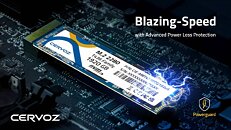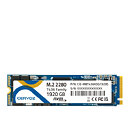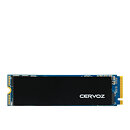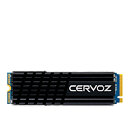T0@st
News Editor
- Joined
- Mar 7, 2023
- Messages
- 3,063 (3.88/day)
- Location
- South East, UK
| System Name | The TPU Typewriter |
|---|---|
| Processor | AMD Ryzen 5 5600 (non-X) |
| Motherboard | GIGABYTE B550M DS3H Micro ATX |
| Cooling | DeepCool AS500 |
| Memory | Kingston Fury Renegade RGB 32 GB (2 x 16 GB) DDR4-3600 CL16 |
| Video Card(s) | PowerColor Radeon RX 7800 XT 16 GB Hellhound OC |
| Storage | Samsung 980 Pro 1 TB M.2-2280 PCIe 4.0 X4 NVME SSD |
| Display(s) | Lenovo Legion Y27q-20 27" QHD IPS monitor |
| Case | GameMax Spark M-ATX (re-badged Jonsbo D30) |
| Audio Device(s) | FiiO K7 Desktop DAC/Amp + Philips Fidelio X3 headphones, or ARTTI T10 Planar IEMs |
| Power Supply | ADATA XPG CORE Reactor 650 W 80+ Gold ATX |
| Mouse | Roccat Kone Pro Air |
| Keyboard | Cooler Master MasterKeys Pro L |
| Software | Windows 10 64-bit Home Edition |
Leading industrial storage and memory provider, Cervoz Technology, introduces the T436 Family: state-of-the-art Industrial PCIe NVMe Gen3x4 SSDs. Compatible with the PCIe Gen3x4 interface, NVMe protocol, and M.2 2280 form factor, the series is a perfect fit for both booting and storage in PCs and motherboards. What sets the T436 SSDs apart is Cervoz's proprietary Power Loss Protection technology. In an era dominated by rapid IoT and AI advancements, our dependency on data is paramount. With global energy fluctuations driven by soaring computing needs, there's more than just a call for swifter data management. It's crucial to protect our data from potential power inconsistencies.
Guarding Data Against Power Instability
The standout feature of the T436 is its advanced PLP (Power Loss Protection) technology. Power disruptions have long been a challenge for SSDs, making valuable data vulnerable to corruption or loss, threatening both data integrity and operational continuity. The T436 SSDs integrate the Powerguard technology to combat these challenges. Upon an unexpected power dip, Powerguard activates instantly, drawing additional power from tantalum capacitors, ensuring that any data within the DRAM buffer is written back to the NAND Flash. Typically, average SSDs require around 40 ms of backup power discharge to complete the data write-in task, influenced by the data's complexity or size. With Cervoz's Powerguard, the buffer time from a power dip to potential failure extends impressively to 88 ms, ensuring that all data has ample time to be written fully.




All of the above is just a part of Cervoz's comprehensive PLP technology. When combined with Safeguard's VDT (Voltage Detector) mechanism, Voltguard's voltage stabilization, and Circuitguard's defense against abnormal currents, Cervoz's PLP offers unrivaled protection against data loss due to power disturbances, ensuring the integrity and security of your essential data.
Uncompromised Speed and Reliability
The T436 family of SSDs is not just about speed; it's also about reliability. With features that range from compliance with NVMe 1.3/PCI Express Base 3.1 standards to the incorporation of industry-leading SSD-grade-quality TLC flash memory from Kioxia, the T436 is designed for efficiency. Moreover, the Cervoz firmware features a robust ECC algorithm—Low-Density Parity Check (LDPC) decoding—together with the End-to-End Data Protection method, ensuring data reliability and integrity. Recognizing the heat generated by high performance, the T436 is available in a wide-temperature version that can reliably operate from -40°C to 85°C. Additionally, the integrated SW-HW overheating protection mechanism, complemented by an optimized heatsink, ensures effective heat dissipation, guaranteeing optimum performance at all times.
Why Cervoz T436 SSDs?
With capacities ranging from 240 GB to 1920 GB, a broad operating temperature range of -40°C to 85°C, dynamic thermal throttling, DRAM Buffer, AES 256-bit encryption, and more, the T436 family offers a comprehensive solution tailored for businesses seeking both performance and unwavering reliability. Whether the need is for rapid data access or consistent operations in power-critical situations, the T436 ensures that businesses stay at the forefront of efficiency and reliability.
View at TechPowerUp Main Site | Source
Guarding Data Against Power Instability
The standout feature of the T436 is its advanced PLP (Power Loss Protection) technology. Power disruptions have long been a challenge for SSDs, making valuable data vulnerable to corruption or loss, threatening both data integrity and operational continuity. The T436 SSDs integrate the Powerguard technology to combat these challenges. Upon an unexpected power dip, Powerguard activates instantly, drawing additional power from tantalum capacitors, ensuring that any data within the DRAM buffer is written back to the NAND Flash. Typically, average SSDs require around 40 ms of backup power discharge to complete the data write-in task, influenced by the data's complexity or size. With Cervoz's Powerguard, the buffer time from a power dip to potential failure extends impressively to 88 ms, ensuring that all data has ample time to be written fully.




All of the above is just a part of Cervoz's comprehensive PLP technology. When combined with Safeguard's VDT (Voltage Detector) mechanism, Voltguard's voltage stabilization, and Circuitguard's defense against abnormal currents, Cervoz's PLP offers unrivaled protection against data loss due to power disturbances, ensuring the integrity and security of your essential data.
Uncompromised Speed and Reliability
The T436 family of SSDs is not just about speed; it's also about reliability. With features that range from compliance with NVMe 1.3/PCI Express Base 3.1 standards to the incorporation of industry-leading SSD-grade-quality TLC flash memory from Kioxia, the T436 is designed for efficiency. Moreover, the Cervoz firmware features a robust ECC algorithm—Low-Density Parity Check (LDPC) decoding—together with the End-to-End Data Protection method, ensuring data reliability and integrity. Recognizing the heat generated by high performance, the T436 is available in a wide-temperature version that can reliably operate from -40°C to 85°C. Additionally, the integrated SW-HW overheating protection mechanism, complemented by an optimized heatsink, ensures effective heat dissipation, guaranteeing optimum performance at all times.
Why Cervoz T436 SSDs?
With capacities ranging from 240 GB to 1920 GB, a broad operating temperature range of -40°C to 85°C, dynamic thermal throttling, DRAM Buffer, AES 256-bit encryption, and more, the T436 family offers a comprehensive solution tailored for businesses seeking both performance and unwavering reliability. Whether the need is for rapid data access or consistent operations in power-critical situations, the T436 ensures that businesses stay at the forefront of efficiency and reliability.
View at TechPowerUp Main Site | Source




